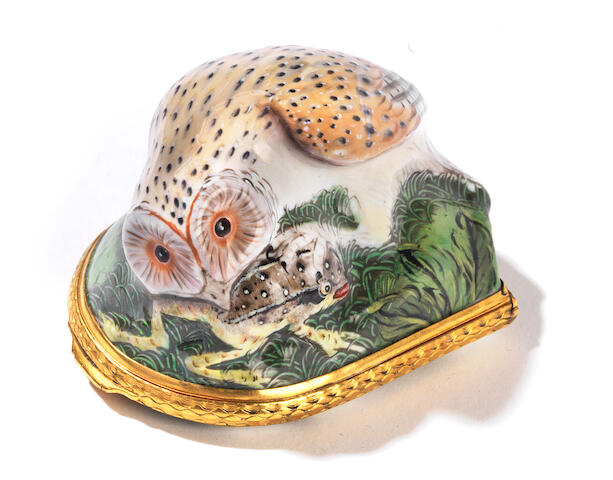 |
| Box 1: Snuff-box or bonbonnière, c. 1760. Sold at Bonhams. Originally from the Mort & Moira Lesser collection. |
Previously I wrote about enamelled frog boxes, but here, I'm afraid, it is bad news for the unfortunate frog. He's owl supper!
Many of these animal-shaped boxes were made between about 1760 and 1780 in Birmingham or South Staffordshire, and depict all kinds of creatures, both exotic and more familiar. They were made using a shaped copper base which was then enamelled and mounted with a decorative rim. The copper shape of this owl must have been particularly difficult to form with his raised wing.
Many of these animal-shaped boxes were made between about 1760 and 1780 in Birmingham or South Staffordshire, and depict all kinds of creatures, both exotic and more familiar. They were made using a shaped copper base which was then enamelled and mounted with a decorative rim. The copper shape of this owl must have been particularly difficult to form with his raised wing.
The bases were also decorated and often were inspired by or copied from popular prints. The lid of the owl box contains an image of an owl being scolded by three birds, sometimes called 'Mobbing Birds', and was probably influenced by the Aesop's Fable The Owl and the Birds. The image was a copy of a print from about 1690, below. The print was engraved by Francis Place (1647-1728) and published by Pierce Tempest (1653-1717), the image itself taken from a drawing by Francis Barlow (1626-1704). These prints and eighteenth-century copies of them could often be bought affordably in sets of six, and are frequently found as being the inspiration (or direct copy) for designs on enamel.
Place was friends with Wenceslaus Hollar (1607-1677) who produced his own visual interpretation of The Owl and the Birds.
 |
| Wenceslaus Hollar, The Owl and the Birds, c. 1650-70. Wenceslaus Hollar Collection. |
 |
| Woodcut for The Owl and the Birds by Virgil Solis (1514-1562). |
Similar Designs
The base was transfer printed, which required a technique similar to copperplate printing, but the ink could be applied and set to the shiny surface of enamel. This could be repeated several times so helped the Birmingham and Staffordshire enamellers mass-produce these boxes, despite them still requiring hand manufacture. Other boxes use the same copperplate image, almost certainly from the same plate including the box below, but without being painted over.
 |
| Box 2: Snuff-box from private collection, c. 1758-60. Transfer printed in black, and probably Birmingham made. |
NOTES
© Jen Dixon 2020. All text belongs to the author (jenni.a.dixon@gmail.com).
- See the Wenceslaus Hollar Collection at Toronto University here.
* Full references on request.


